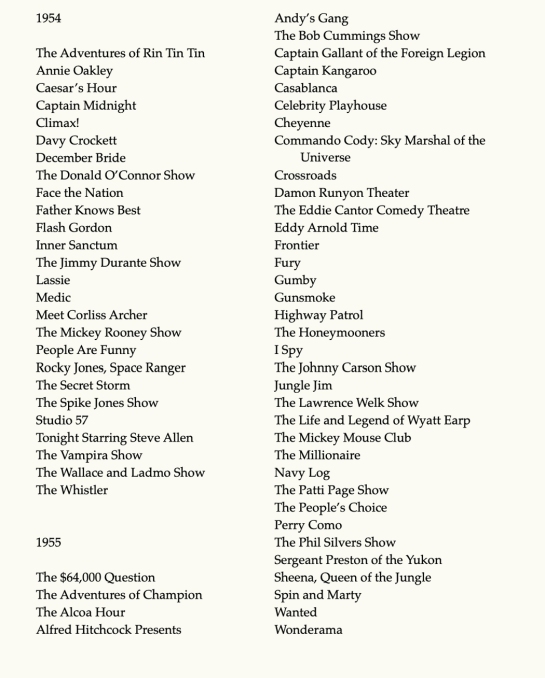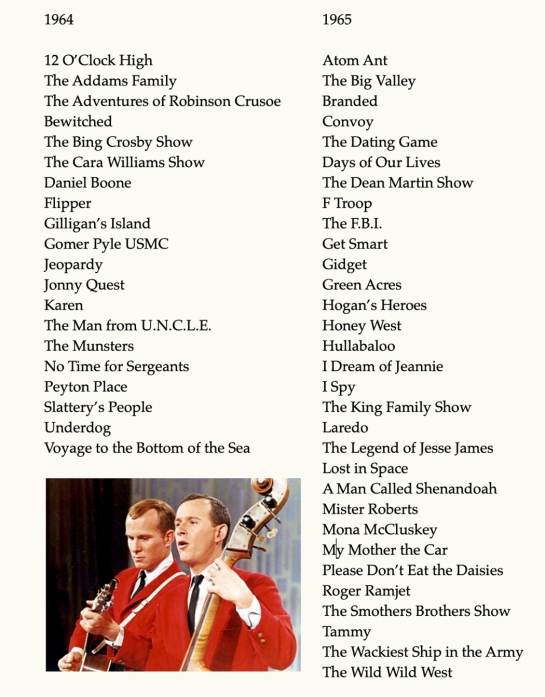I was born in 1948 and shared my infancy with television. Me and Uncle Miltie saw the light of day in the same instant of time, just a few clicks after the end of the war that killed 60 million people. Uncle Miltie was fun.
 My father still fit into his Eisenhower jacket and automobiles were just being remarketed, having been turned back from the Sherman Tank pumpkins they had been for the duration. I, of course, knew nothing of this: I was eating pureed prunes and slapping my sippy cup on the tray of my high chair and gurgling with ignorant happiness.
My father still fit into his Eisenhower jacket and automobiles were just being remarketed, having been turned back from the Sherman Tank pumpkins they had been for the duration. I, of course, knew nothing of this: I was eating pureed prunes and slapping my sippy cup on the tray of my high chair and gurgling with ignorant happiness.
I can’t remember a time when we didn’t have a television in the house. Some of my earliest memories were of watching that ovoid 12-inch screen in our house in Teaneck, N.J. and being told that I entered the world in the same hospital where Ozzie and Harriet’s son, Rickey, was born.
Those early broadcast years were sparse. There was a test pattern on the screen until about six in the morning, and by midnight the National Anthem played over a picture of a waving flag, followed by a high-pitched sine-wave note and that familiar test pattern.
 In between, broadcasters scrambled for what today we call “content.” They found old movies, silent slapstick comedies, talk shows and, ever the staple, variety shows. What original material they had wasn’t really original, but was translated from radio. Many of the old familiars were now filmed (or performed live) and given new life. The Life of Riley, The Goldbergs, The Aldrich Family, My Friend Irma, Jack Benny, and George Burns and Gracie Allen. William Boyd repackaged his old Hopalong Cassidy westerns from the Thirties and such cowboy shows as The Cisco Kid and The Lone Ranger filled Saturdays for the wee bairns.
In between, broadcasters scrambled for what today we call “content.” They found old movies, silent slapstick comedies, talk shows and, ever the staple, variety shows. What original material they had wasn’t really original, but was translated from radio. Many of the old familiars were now filmed (or performed live) and given new life. The Life of Riley, The Goldbergs, The Aldrich Family, My Friend Irma, Jack Benny, and George Burns and Gracie Allen. William Boyd repackaged his old Hopalong Cassidy westerns from the Thirties and such cowboy shows as The Cisco Kid and The Lone Ranger filled Saturdays for the wee bairns.
Before I was sent off to kindergarten, I watched daytime TV with my mother as she ironed or cooked. Art Linkletter, Arthur Godfrey, Herb Shriner, and Dave Garroway, always Dave Garroway, with his meaty palm held toward the screen as he signed off the Today Show each morning: “Peace.”
 For the evening, a host of second-string movie actors stepped up as top bananas in sitcoms: Eve Arden, Stu Erwin, Joan Davis, Gale Storm, Ann Sothern, Robert Cummings, Leon Ames, Wendy Barrie, Harriet Hilliard and Ozzie Nelson, and the greatest leap up from B-films: Lucille Ball.
For the evening, a host of second-string movie actors stepped up as top bananas in sitcoms: Eve Arden, Stu Erwin, Joan Davis, Gale Storm, Ann Sothern, Robert Cummings, Leon Ames, Wendy Barrie, Harriet Hilliard and Ozzie Nelson, and the greatest leap up from B-films: Lucille Ball.
And the kiddie shows. Howdy Doody was the royalty, but the rest of the aristocracy included Kukla, Fran and Ollie, Romper Room, Ding-Dong School, Captain Video, Beany and Cecil the Seasick Sea Serpent, Crusader Rabbit and Mr. Wizard.
Three genres ate up a great part of the clock: game shows (Beat the Clock, Truth of Consequences, What’s My Line, Name That Tune), Westerns (Roy Rogers, Gene Autry, Sky King, The Adventures of Wild Bill Hickock, Hopalong Cassidy), and space operas (Tom Corbett, Space Cadet, Captain Video, Space Patrol, Rocky Jones, Space Ranger, Captain Midnight). At least, on our TV.
And to fill up the empty programming hours, there were endless old Western movies. The cream were from the 1930s, with Hoot Gibson, Buck Jones, Tim McCoy, Hoppy, Bob Steele, Bob Livingston, John Wayne (in his B-movie phase). The quality plateaued in the ’40s with Johnny Mack Brown, Rogers, Autry, Wild Bill Elliott, and Buster Crabbe, and then dropped significantly after that with some truly awful films with Lash LaRue, Whip Wilson and Tim Holt. The ’50s were bad for movies in general, but disastrous for Westerns — the best of them were now made for TV directly.
I haven’t forgotten the variety shows. Way too much singing for my childish tastes. My parents loved Perry Como, Dinah Shore, Patti Page, Kate Smith and Tennessee Ernie Ford. Me, not so much. But the parental units had the power over us powerless kids and so we watched.
Toast of the Town, later called The Ed Sullivan Show, dominated our Sunday evenings. Nothing like plate spinners for the imaginations of 5-year-olds. Jugglers, ventriloquists, comics, animal acts, and Broadway tunes. The dying gasp of vaudeville.
But, I’m just naming names here, and gorging on nostalgia. What I really meant to do was point out the changing tenor of early television. I see three major periods from 1948, when I was born, to 1970, when I graduated college and pretty much ceased watching the tube on any regular basis. I’m afraid I lost touch with pop culture at that time.
The first period was the one I call “Spaghetti on the Wall.” Audiences were familiar with radio, and television was radio with pictures. To fill the time-void, broadcasters tried pretty much everything trying to figure out just what this new beast was. Talk was cheap, so many of the programs, like Arthur Godfrey, Garry Moore or Art Linkletter’s House Party went on for hours filling the airwaves with chatter. Radio had half-hour sitcoms and hour-long dramas, and so TV did the same. Music was big on radio, more the same on the tube.
There was an innocence in these first 10 years. A certain “Let’s put on a show” attitude. There were hits, such as Sullivan and I Love Lucy, but a lot of dead ends, too. Some old performers just didn’t have the TV magic and Ed Wynn, Jimmy Durante, Fred Waring, Ted Steele, Paul Whiteman, and Red Buttons simply didn’t translate well. (Loretta Young, who started out in silent films, attempted to remain 20 years old well into her 60s).
In the second period, beginning in 1957 or 1958, TV develops a confidence of its own, a kind of throaty adolescence. Radio was no longer something most audiences remembered, except as the source for rock and roll music, and some studios, such as Desilu and Warner Brothers began making TV-appropriate series. It was also the first time TV began remaking, not radio shows, but previous TV shows. There were a new Dinah Shore Show, a new Tonight Show with Jack Paar, new vehicles for Ann Sothern, George Burns, Ernie Kovacs, Gale Storm, Bob Denver, Jim Nabors and even Beany and Cecil.
It was also the era of the explosion of cheap animation. Joseph Hanna and William Barbera pumped out assembly-line cartoons, beginning with The Ruff and Reddy Show in 1957, followed by Huckleberry Hound (with Yogi the Bear), Deputy Dawg, and The Flintstones. Similar animation came from Jay Ward et al. in the various Rocky and Bullwinkle shows.
But the real prize came with popular filmed series, many from Warner Brothers, including Cheyenne, Sugarfoot, Maverick, 77 Sunset Strip, Hawaiian Eye, and Surfside 6. There were other stalwarts, such as Have Gun-Will Travel, Perry Mason, Naked City, Sea Hunt, One Step Beyond, Bonanza, Rawhide, The Untouchables, Route 66, and East Side/West Side.
And The Twilight Zone (and its poor relation, The Outer Limits).
This is the era that brought us a normalized suburban vision of the U.S. and its country cousin. Dick Van Dyke and The Beverly Hillbillies. Leave It to Beaver and The Real McCoys. The Donna Reed Show and The Many Loves of Dobie Gillis vs. The Andy Griffith Show and Petticoat Junction. These were the Eisenhower Years reflected in My Three Sons and The Bob Newhart Show.
This was TV in its stride, its first full flowering as the universal entertainment medium for the vast majority of Americans.
After, comes a period of decadence, of imitation and slipshod production. Instead of The Man from U.N.C.L.E., we get The Girl from U.N.C.L.E. There’s Voyage to the Bottom of the Sea, Fantastic Voyage, and Voyage to the Center of the Earth.
It was also the time of America’s cultural paroxysm and it shows on the screen. Black actors and entertainers showed up beyond Beulah and Amos ’n’ Andy: Julia, The Leslie Uggams Show, I Spy, Nichelle Nichols on Star Trek, The Bill Cosby Show and Flip Wilson. The counter culture ruled The Mod Squad and Laugh-In. It was clear the world was changing …
…and TV’s response was to go for the cheese. The second half of this third era of television history is really dominated by the shows remembered fondly by Generation X and those who saw these things in later syndication. This is The Brady Bunch and The Partridge Family. Adam-12, Love, American Style, The Flying Nun, Ironside, My Mother, the Car, Kung Fu, The Six Million Dollar Man, Wonder Woman. There was a full reliance on gimmicks. And what didn’t depend on a gimmick still felt like a bad parody — even a deconstruction — of what bad TV is all about. Some young people, grown up in a world of media rather than one of sky, sea and soil, enjoy such programs in cable reruns precisely because of how bad they are.
Television itself has become so much more self-aware as television. Postmodernism hit the medium with a wallop. You can’t have a David Letterman without the irony of his take on the very medium that brings him bread.
This has all been a very broad overview. Certainly, there have been good shows in each era. Even in the ruins of decadence we have Mary Tyler Moore, All in the Family, M*A*S*H, The Rockford Files, Barney Miller, Soap, and Taxi. There are always creative people in the field: No era is complete dross.
I have very fond recollections of the TV I watched as a child and no doubt rank such shows higher in my estimation than they deserve and no doubt each generation feels something of the same for the fare they ingested in their formative years. We should all be forgiven the folly of our youths. 
I rather lost track of the toob after going to college and since graduating. I have caught bits and pieces and I’m afraid I am rather disgusted with the current 24-hour news channels. This has been called a new “Golden Age” of TV, and no doubt it is: The quality levels of much is quite high, at least on cable and on streaming services. The networks seemed largely mired in repetition of the same cafeteria food. I find myself turning primarily to Turner Classic Movies, PBS, and British television. Or perhaps, cracking open a book.
But then, I am a crotchety old geezer.


















